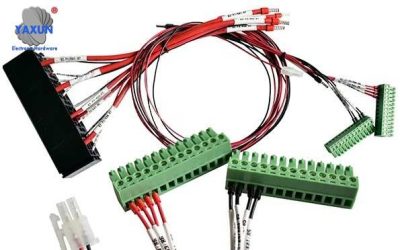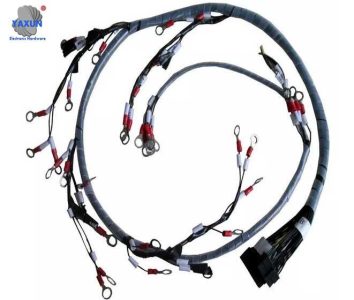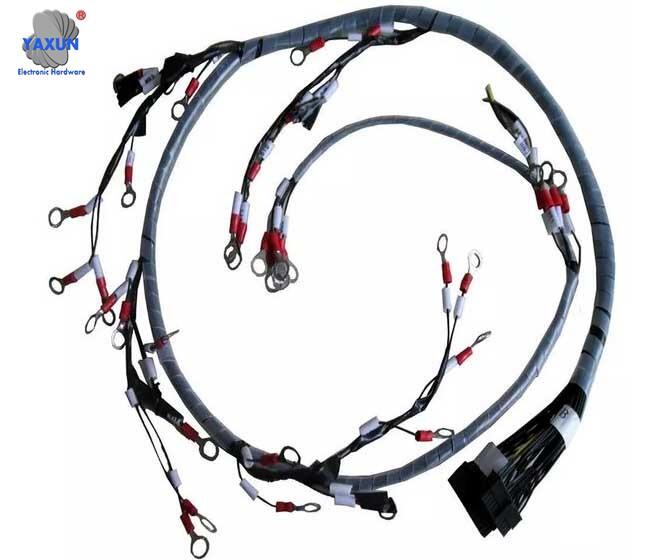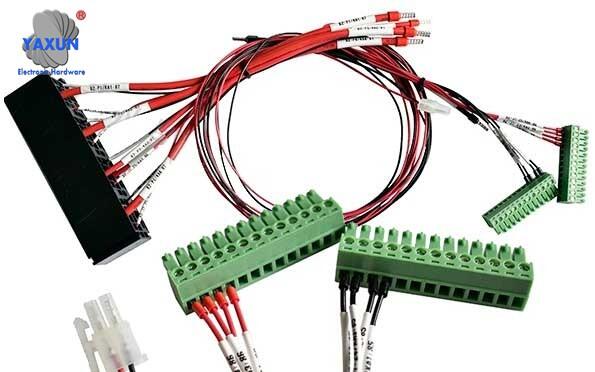catégories de produits
Mots clés du produit
Messages récents
automatisation du jeu de faisceaux de câbles assistés par robot
Le flux de processus de fabrication de faisceaux de câbles pour robots comprend généralement les étapes suivantes:
Conception et planification: Concevoir la mise en page, méthodes de connexion et caractéristiques électriques du faisceau de câblage en fonction des besoins et exigences fonctionnelles du robot. Tenir compte de facteurs tels que la section transversale du fil, longueur, codage couleur et nombre de conducteurs.
Materielle préparation: Sélectionnez des fils de haute qualité, connecteurs, manchons de protection et autres accessoires adaptés aux applications robotiques. S'assurer que les matériaux sont conformes aux normes et spécifications pertinentes de l'industrie.
Customized robot harness according to your drawing or sample requirements.
Fil: UL1015, UL1007;
Connecteur: tubular terminal KT, spring terminal;
Application fields: sweeping robots, mechanical arm robots, industrial robots, etc.;
Name: Robot wire harness; Processing technology: riveting, assembly and molding;
Customized according to customer needs: wire harness length, specifications, color, etc.;
Wire harness exterior: heat shrink tubing;
Fil: UL1015, UL1007;
Withstand voltage: DC300V, 10 milliseconds;
Connecteur: tubular terminal KT, spring terminal;
On-resistance: ≤2 ohms;
Waterproof grade: IP67;
Insulation resistance: ≥10 megohm;
Plug and unplug cycle: ≥5000 times;
Salt spray test: ≥48 hours;
Application areas: sweeping robots, mechanical arm robots, industrial robots, etc..
Robot wire harness drag chain cables are mainly suitable for occasions with frequent movement and bending. Because more ordinary cables should have: high flexibility, résistance à l'huile, shallow water resistance, moisture resistance, UV resistance, excellent weather resistance, résistance aux basses températures, se résistance à l'usure, and the ability to withstand heavy mechanical external forces. The cable has faster acceleration and stronger bending resistance than ordinary flexible cables.
The robot wire harness has characteristics such as high torsion resistance. It is cleverly routed between the curved robotic arms and can withstand a large number of bends, which greatly increases the service life of the equipment.
Product certification: Ul, IPC620, IP67, REACH, ROHS2.0, MASDS
Company honors and qualifications: National High-tech Enterprise, Ul, IPC620, ISO9001, ISO14000, ISO13485, IATF16949, etc..
Robot wiring harness refers to the cable and wiring harness system used to connect various parts and components of the robot. It includes multiple wires, connecteurs, protective sleeves and other accessories used to transmit power, signals and data to achieve robot movement, control and communication.
Le flux de processus de fabrication de faisceaux de câbles pour robots comprend généralement les étapes suivantes:
Conception et planification: Concevoir la mise en page, méthodes de connexion et caractéristiques électriques du faisceau de câblage en fonction des besoins et exigences fonctionnelles du robot. Tenir compte de facteurs tels que la section transversale du fil, longueur, codage couleur et nombre de conducteurs.
Materielle préparation: Sélectionnez des fils de haute qualité, connecteurs, manchons de protection et autres accessoires adaptés aux applications robotiques. S'assurer que les matériaux sont conformes aux normes et spécifications pertinentes de l'industrie.
Wire processing: According to the design requirements, the wires are peeled, cut and soldered. Make sure the wire ends have good electrical contact and wire insulation.
Connector assembly: Insert the wire into the connector, and assemble and fix the connector. Ensure good contact and stable connection between connector and wire.
Sleeving Installation: Place protective sleeves or sheaths over wire harnesses to provide physical protection and electromagnetic shielding of the wires. Make sure the wire harness is sufficiently flexible and abrasion-resistant.
Quality inspection: Strict quality inspection and testing of manufactured wire harnesses, including wire connectivity testing, insulation testing, electrical parameter testing, etc.. Ensure that the wiring harness meets design requirements and relevant standards.
Labeling and packaging: Label and package the wiring harness for easy installation and use. Identification usually includes information such as conductor function, color coding, et longueur.

Installation du faisceau de câbles du robot

Faisceau de câblage du robot à bras mécanique
Features of robotic harnesses include:
Complexity: Robotic wiring harnesses often contain large numbers of wires and connectors used to carry multiple types of power, signals and data. The layout and connection of the wire harness need to be precisely designed based on the structure and function of the robot.
Flexibility: The robot harness needs to be flexible and flexible enough to adapt to the movement and posture changes of the robot during work. The design and material selection of the harness need to take into account the robot’s freedom and workspace requirements.
Durability: Robotic wiring harnesses are often subjected to repeated motion and vibration over long periods of time, so they need to have good durability and resistance to wear and tear. The selection of wire harness materials and connection methods must be able to withstand the requirements of the robot’s working environment.
Electromagnetic shielding: Since electromagnetic interference may exist during robot operation, the wiring harness needs to have a certain electromagnetic shielding capability to prevent interference from affecting signal transmission and system performance.
Safety: Robot wiring harnesses need to comply with relevant safety standards and regulatory requirements to ensure the safety of the wiring harness. Wiring harnesses need to undergo rigorous quality inspection and testing to avoid potential electrical problems and failures.
The manufacturing process and characteristics of the robot harness enable it to provide reliable power, signal and data transmission, supporting accurate control and efficient operation of the robot. Precise design and manufacturing processes ensure the stability and reliability of the wire harness, thereby improving the robot’s work efficiency and performance.
Contactez-nous
En attente de votre email, nous vous répondrons dans les 12 heures avec des informations précieuses dont vous aviez besoin.
 English
English العربية
العربية Български
Български 中文(漢字)
中文(漢字) Čeština
Čeština Dansk
Dansk Eesti keel
Eesti keel Suomi
Suomi Français
Français Deutsch
Deutsch Ελληνικά
Ελληνικά עברית
עברית Magyar
Magyar Bahasa Indonesia
Bahasa Indonesia Italiano
Italiano 日本語
日本語 한국어
한국어 Latīna
Latīna Latviešu valoda
Latviešu valoda Lëtzebuergesch
Lëtzebuergesch Polski
Polski Português
Português Română
Română Русский
Русский Slovenščina
Slovenščina Español
Español Svenska
Svenska ภาษาไทย
ภาษาไทย Tiếng Việt
Tiếng Việt


